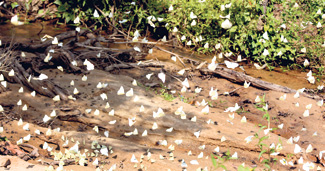The ‘Kumana’ wildlife sanctuary – better known as a ‘bird paradise’ was reopened recently after a lapse of nearly six years. Kumana has, in fact, not been a regular destination for travellers for the past two decades due to the LTTE threat.
Once known as one of the best or rather the best bird sanctuary in Asia, Kumana is now slowly getting back to its past glory.
 |
| Pretty picture: Butterflies in flight. |
 |
Located in the southeast corner of Sri Lanka about 22 km off Panama, the 35,664 hectare park is a well-known eco-tourism attraction where a multitude of birds breed and roost. After being gazetted in 2006, Yala East National Park was renamed as ‘Kumana National Sanctuary’ changing the original name and the extent of land originally gazetted in 1970.
After travelling for more than 10 hours, we reached Kumana passing the mysteriously attractive Panama.
One of the most significant features of the park is the 'Kumana Villu' - a 200 hectare natural swamp lake, fed by the 'Kumbukkan Oya' through a half mile long narrow channel. It is at this mangrove swamp that many water birds nest in May and June.
Our guide Tissa Ariyawansa was captured and later released by the LTTE in 2005. “They burnt down all the bungalows inside the park but we still stayed on despite their warning,” he said.
Tissa is well versed in Kumana lore. Regular sightings of birds include pelicans, painted storks, spoonbills, white ibis, herons, egrets and hundreds of little cormorants. The very rare black-necked stork has also been spotted at the swamp, he says. According to Tissa, nearly 255 species of birds have been recorded in the national park. During April–July, tens of thousands of birds migrate to the Kumana swamp area annually.
Migrant birds have now started to move out of the region leaving the endemics to rule the land.
A significant sight as we entered the park was the millions of butterflies covering the wet spots of the land and the pathways. According to Tissa, that is the usual way the butterflies drink water. This causes a minor problem for safari vehicles and vehicles of the visitors who find it difficult to avoid running them over.
Besides its prolific birdlife, Kumana is also home to some of the mammals found in the larger Yala National(West) Park, such as elephants, leopards and Golden Jackal, though we were not lucky enough to see any leopards, only a few elephants and jackals. The Mugger Crocodile, Indian Flap-shelled Turtle and Indian Black Turtle are the common reptiles inhabiting the park.
The vegetation in Kumana consists mainly of mangroves, kumbuk trees and the karan fern, as well as open marsh land. For bird watching enthusiasts, the park is an 'absolute must' despite the number of birds observed in the national park having fallen in recent years, said Tissa due to the damage caused during the last three to four decades.
The campsite is still open but the other infrastructure is lacking. Rebuilding the once popular bungalows is still on hold.
Environmentalists and wildlife lovers have also expressed their concern over a road planned to be constructed from Kirinda to Panama which will run along the coastline.
“The threat is not over yet. We have to face new challengers now, may be more than terrorists. Our main aim is to protect the wildlife, and nature. We are dedicated to do that under any circumstances,’ said Tissa.
A little history
The Kumana area is part of an ancient civilization that goes back to the 3rd century BC.‘Rock inscriptions belonging to the 2nd and 1st centuries BC have also been found in the region,” guide Tissa Ariyawansa said.
The Kumana National Park lies on the route of the Pada Yatra- the traditional annual foot pilgrimage to the Hindu temple at Kataragama.
The original God Skanda (Kataragama) devalaya was found on the banks of Kumbukkan Oya on the border of Yala Block 3.
Pilgrims have already started to visit this place of worship after three decades. |



